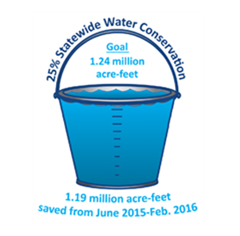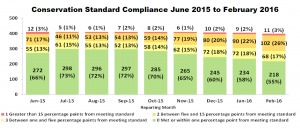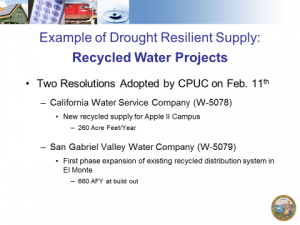In April, the State Water Resources Control Board (SWRCB) announced that nearly 1.19 million acre-feet of water were conserved from June 2015 through February 2016, achieving 96 percent of the established goal of 1.24 million acre-feet of water. According to SWRCB’s April 4 media release, “Water saved during the nine-month period is enough to supply more than 5.9 million Californians for one year; this is approximately the combined population of San Diego, Riverside, and Tulare counties, or 15 percent of the state’s population.”
Although the statewide cumulative savings from June 2015 to February 2016 of 23.9 percent fell slightly short of Governor Brown’s 25 percent mandate, SWRCB Chair Felicia Marcus was pleased with the results. “Twenty-four percent savings shows enormous effort and a recognition that everyone’s effort matters. Californians rose to the occasion, reducing irrigation, fixing leaks, taking shorter showers, and saving our precious water resources in all sorts of ways,” noted Marcus.
The customers of investor-owned water companies (IOWCs) certainly have done their part in conserving.
- Through February 2016, IOWCs averaged a 26.1-percent cumulative reduction in water production for customers, compared with the statewide average of 23.9 percent.
- IOWCs accounted for 18 percent of the total 1.19 million acre-feet savings statewide.
- Of the 59 IOWC reporting districts, 36 achieved their conservation targets – 43 were within one percentage point, 51 within five points and 59 within nine points.
State Water Board Considers Changes to Emergency Regulation
Prior to the release of the updated conservation figures, the California Water Association (CWA) weighed in on potential adjustments to the Extended Emergency Regulation (EER), adopted in February 2016.
Once again, CWA opposed permanent mandated reductions in water use, taking the position they are unnecessary once drought conditions subside. CWA applauded the SWRCB for including provisions in the EER allowing reductions in mandated conservation standards of up to 8 percent based on particular characteristics of a water system, but contended that further adjustments, based on local water supply conditions, are now warranted.
Recognizing the impacts of 2016’s El Niño were far more significant in Northern versus Southern or Central California, CWA agreed that caution should be employed in relaxing the EER. However, with improved conditions in Northern California and to help water suppliers maintain their credibility with customers, CWA urged the State Water Board to adopt a progressive approach in changing the EER, beginning with statewide actions, moving to regional actions and concluding with individual utility assessments:
- Continue promoting conservation efforts by all water users in California (statewide);
- Reduce the mandated conservation standards for all water systems by a percentage reflecting the alleviation of statewide drought conditions (statewide);
- Remove any caps on adjustments and credits allowed under the EER (statewide);
- Allow additional credits for water systems and regions that previously have made substantial long-term investments to augment water supplies (regional); and
- Allow further reductions in mandatory conservation standards for water suppliers that can show they are no longer subject to significant water supply constraints due replenished sources of supply (local/individual utility assessments).
CWA reiterated this progressive approach in an April 14 letter responding to the request for comments prior to SWRCB’s Urban Water Conservation Workshop on April 20.
CWA recommended the measures above in addition to allowing local jurisdictions, such as the Santa Clara Valley Water District, to continue establishing local conservation requirements as appropriate.
In his February 23 Water Utilities Update to the Low-Income Oversight Board, Viet (Kevin) Truong of the California Public Utilities Commission’s Division of Water and Audits noted that IOWCs are doing their share having contributed 180,000 acre-feet or 17 percent of the total water conserved from June through December 2015 of the total saved by all urban water suppliers in the state. Truong also highlighted California Water Service Company’s and San Gabriel Water Company’s recycled water projects as examples of drought-resilient supplies.
As IOWCs continue to implement conservation programs and projects, CWA will continue monitoring and commenting on regulatory changes.







